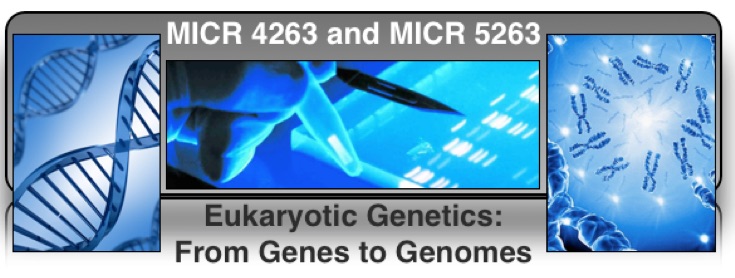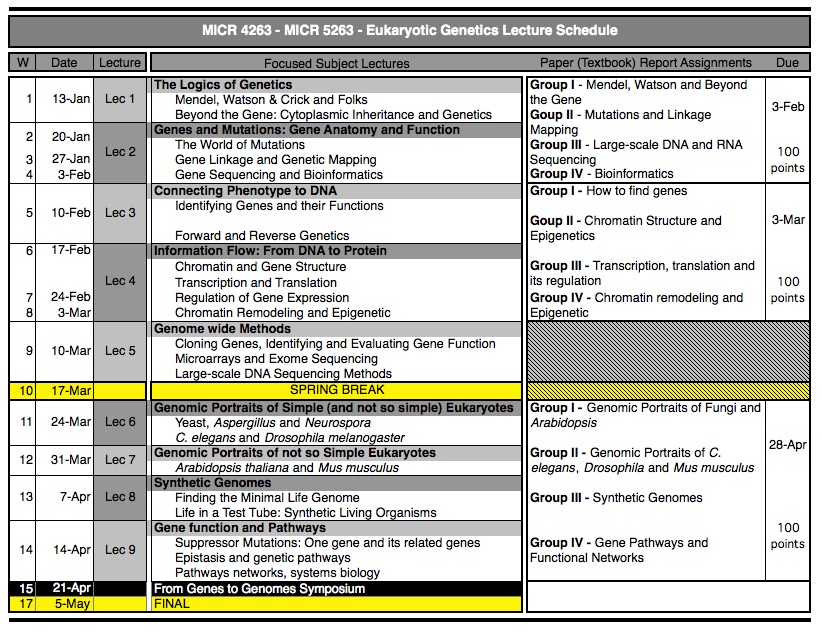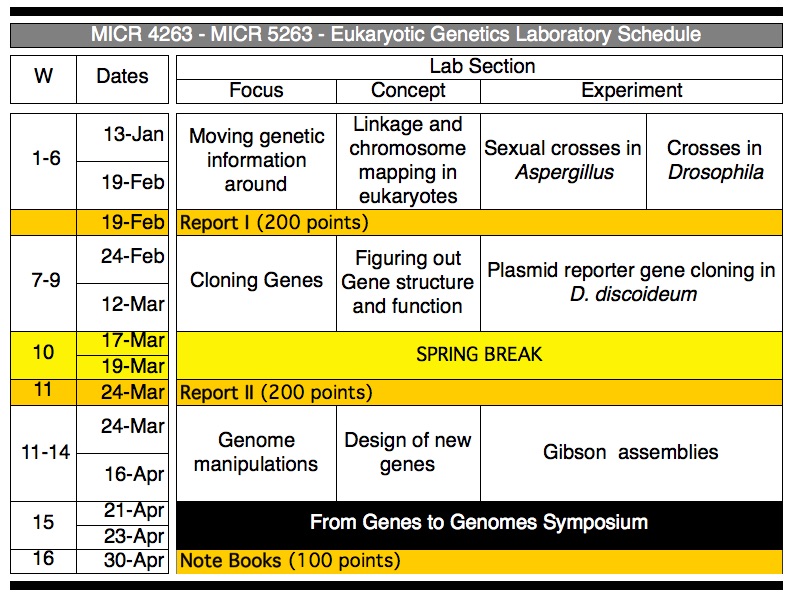
MICR4263 and MICR5243 Eukaryotic Genetics: From Genes to Genomes
Syllabus
Instructor Rolf A. Prade, Room 409 LSE, Tel: 405 744 7522, E-mail prade@okstate.edu. Office hours: by appointment. Laboratory Instructor: Garry Marley, Room LSE301. Tel: 405 744 6411. Teaching Associate: TBA. Office hours: by appointment.
Lectures: Tuesday, 12:30 PM -1:20 PM Location TBA. Laboratory: Tuesdays and Thursdays, 10:30 AM-12:20 PM LSE301.
Course Description Integration of genetics and genomics principles, the basic processes of gene transmission, molecular biology of gene expression and evolutionary genetics by gaining social and historical context in which genetics has developed. Participants are expected to comprehend the dramatic change in our understanding of eukaryotic genetics and the role such information has in our view of disability and disease.
Prerequisites MICR 2123 and one of MICR 3033, PLP 3344 or BIOCH 3653
Rules and Policies OSU rules and policies will be strictly enforced, specially regarding academic dishonesty/misconduct, special accommodations for students, retention & grading policies, class attendance and add & drop dates
Objectives and Format This course has been designed to give students a unique opportunity to observe and explore the world of genes and their organization into genomes and face some of the contemporary problems of medicine and biotechnology. As you probably are aware, genetic principles underline modern medicine, biotechnology of pharmaceuticals and the development of cures for diseases.
Two modules contain the course: lectures (that will provide you with historical and contemporary background information) and laboratory experiments (that will allow you to observe genes in action in a series of experimental systems). The course is designed to attend the needs of undergraduate cell and molecular biology, microbiology and biology, majors with emphasis in the medical field.
Scoring Evaluations of three assignments (papers), two lab reports and one oral presentation during the “From Genes to Genomes Symposium” will make up at least 90% of the final grade. There will be 1000 possible points.
Paper Assignments. Paper assignments (PA) need to be written and formatted in scientific language containing Title, Abstract, Introduction, Report Section, Figures & Tables, Discussion, Conclusion and References cited.
PA1 Cloning with E. coli. Research how cloning genes started in history using plasmids and E. coli strains. Suggested topics: E. coli strains as cloning tools, Plasmids, E. coli transformation, Restriction enzymes, CALF(SHRIMP) phosphatases, T4 Kinase and T4 DNA ligase, Agarose gel electrophoresis, Isolation of DNA fragments and more such as Southern blots, cDNAs, reverse transcriptase.
PA2 Evolution of DNA Sequencing Technologies. Research how the first DNA fragment was sequenced both by the chemical (Maxam-Gilbert) and biological (Sanger) method. Further research how DNA sequencing technologies evolved to today’s Ultra-high-throughput sequencing technologies. Discuss the implications and applicability of large scale DNA sequencing. Suggested topics: Chemistry of DNA sequencing, Evolution of sequencing technologies; Massively parallel signature sequencing (MPSS), Polony, 454 Pyro, Illumina (Solexa), SOLiD, Ion Torrent semiconductor, DNA nanoball and single molecule sequencing such as Heliscope, SMRT and Nanopore DNA sequencing.
PA3 Restriction Enzyme Free Cloning Techniques. Research recent advancements in cloning techniques that avoid the use of restriction enzymes. These cloning techniques rely mostly on PCR amplification of DNA fragments with overlapping DNA-ends. Suggested topics: Traditional cloning methods and new improved methods such as Ligation Independent Cloning (LIC), USER, SLiCE, Gibson Assembly, Aqua Cloning and CRISPR/Cas9.
Symposium A two-day symposium will engage students in the discussion of the latest papers in Genetics. Guidelines on how to participate in the symposium and what to present will be published later. Visit the latest Symposium Article Selection Page for insights.
Lab Reports All experiments conducted in the lab need to be reported, written and formatted in scientific language. Reports should have an Abstract, Introduction, Material and Methods, Results and Discussion. Lab Report I should describe the sexual cross conducted with Aspergillus nidulans and Drosophila melanogaster. Each cross should be described individually and a global discussion about genetic mapping using recombination frequencies should be provided. Lab Report II should describe cloning and gene manipulation techniques including the construction of a recombinant eukaryotic organism. Note books should be carefully kept describing all the experiments. Notebooks are worth 100 points (at the discretion of the TA).
Guidelines for Graduate Credit Graduate enrollees must submit to the instructor by the date of the final exam a full-length referenced review paper of at least 5,000 words. The subject to be reviewed will be a course lecture topic and consent of the instructor is required.
Preliminary Lecture Outlines

Preliminary Laboratory Outlines

